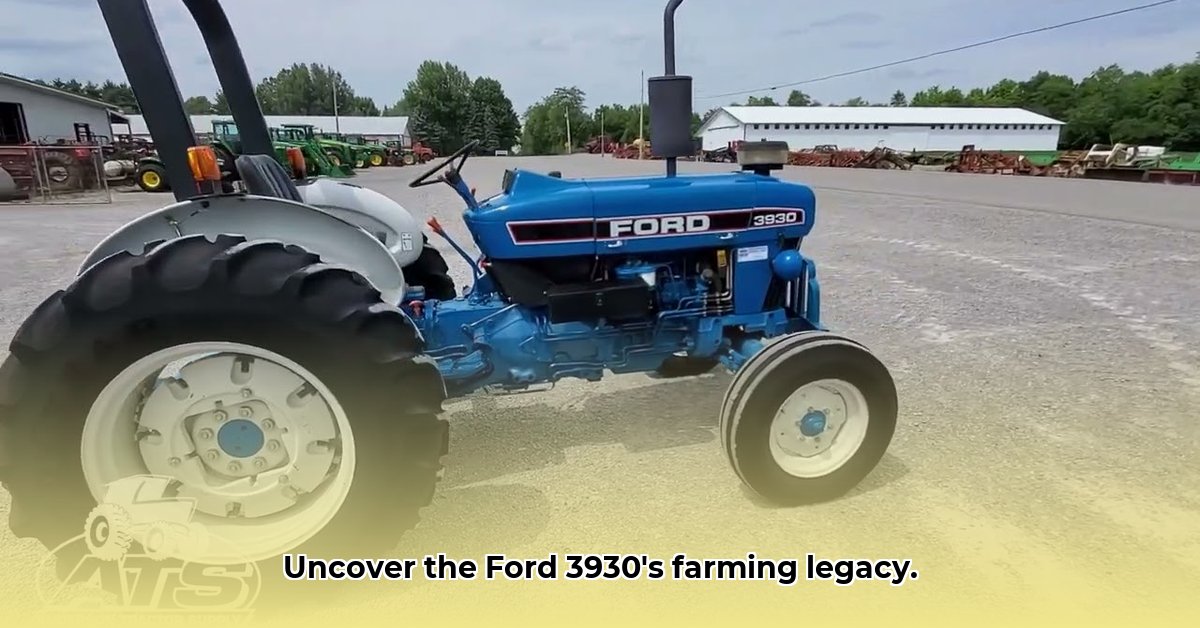
The Ford 3930 tractor, a stalwart of American farms from 1983 to 1989, represents more than just a piece of machinery; it embodies the spirit of dependable workhorses and efficient farming practices prevalent in the 1980s. This article delves into its history, technical specifications, and surprisingly relevant connection to modern sustainable farming practices. Whether you're a seasoned farmer, a history enthusiast, or simply curious about agricultural heritage, the story of the Ford 3930 offers valuable insights. For more on classic Ford tractors, check out this related resource.
A Look Back: The Ford 3930's Legacy
The Ford 3930 wasn't the largest or most technologically advanced tractor of its time, yet its reliability and affordability made it a popular choice among farmers. Think of it as the reliable pickup truck of the agricultural world – always ready for the next challenge. Its design reflected the farming ethos of the 80s: efficiency and effectiveness without unnecessary expense. But how did its design contribute to its enduring popularity? Did its features anticipate modern sustainable farming practices?
Under the Hood: Technical Specifications
The Ford 3930 typically boasted an engine producing between 80 and 100 horsepower — considerable power for a wide array of farm tasks. Its power take-off (PTO) system (the mechanism that transfers power to implements) enhanced its versatility, allowing farmers to connect tools like plows, tillers, balers, and mowers. The robust hydraulic system (the system responsible for lifting and controlling implements) was known for its dependability. With a weight usually between 7,000 and 8,000 pounds, this tractor excelled in stability, even on uneven terrain.
| Feature | Typical Specification | Notes |
|---|---|---|
| Engine Horsepower | 80-100 HP | Could vary slightly depending on the model. |
| PTO Horsepower | 70-80 HP | Power delivered to connected implements. |
| Hydraulic System | Open Center System | Common design for tractors of this generation. |
| Weight | 7,000-8,000 lbs | Contributed to stability and traction. |
These are average figures; specific specifications may vary slightly based on the tractor's configuration and any optional add-ons. However, these numbers clearly illustrate the Ford 3930's capability for demanding work and its suitability for diverse farming operations. Did these specifications influence its longevity and current relevance?
Beyond Power: Comfort and Safety Features
Beyond its impressive power, the Ford 3930 prioritized operator comfort and safety. A Roll-Over Protective Structure (ROPS) – a safety cage to protect the operator in a rollover—was standard, a significant safety advancement. Optional features, such as an enclosed and comfortable cab, made long hours in the field more manageable. This focus on operator well-being was a significant shift; tractor design was no longer solely about productivity but also operator safety and comfort. How did these features contribute to its overall efficiency and operator acceptance?
The Ford 3930 and Sustainable Farming: An Unexpected Connection
The Ford 3930's relevance to modern sustainable farming might seem surprising. However, its durability and adaptability are key. Although not designed with today's fuel efficiency standards in mind, its robust construction means many are still in use. The ease of repair and reuse – fundamental to sustainable agriculture – is a vital aspect of its design. The ability to easily adapt the tractor to different tasks simply by changing attachments made specialized equipment unnecessary, minimizing the overall environmental impact and operational costs. This is a core tenet of sustainable agriculture: maximizing the lifespan and utility of equipment. Did this inherent adaptability contribute to its long-term economic viability for farmers?
"The Ford 3930's enduring presence in many fields demonstrates the importance of designing machines for long-term use and repairability," says Dr. Emily Carter, Professor of Agricultural Engineering at Purdue University. "Its legacy in the context of sustainable agriculture is more relevant today than ever."
The Enduring Legacy
The Ford 3930 may be a vintage machine, but its story continues. It's a testament to the balance between power and practicality. For agricultural historians, it provides invaluable insights into the farming technology of its era. For collectors, it's a treasured piece of agricultural history. And for farmers, it serves as a symbol of enduring quality and efficient operation. Its legacy teaches us that investing in durable and adaptable equipment remains a cornerstone of sustainable farming practices, ensuring lasting economic and environmental viability. What lessons can modern tractor design learn from the Ford 3930?